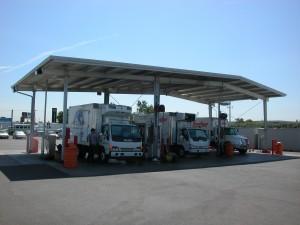The affects of Hurricane Sandy on the supply chain are still being felt now two weeks later. Some businesses are still working off of generators, while others are still trying to locate lost inventory. Some companies are ramping up a little quicker, though, because they prepared in advance to mitigate some of the supply chain disruptions the storm could cause. One of those companies is Ryder.
Preparing for Hurricane Sandy
Ryder has an Emergency Management Plan that includes specifics around procedures that should be followed in the case of a hurricane. This includes protecting employees, vehicles, and facilities and recovering business operations managed on behalf of their customers. Having been through several natural disasters over the past few years, Ryder has learned many lessons in mitigating disruption.
When it became clear that Hurricane Sandy posed a big threat, Ryder began working with customers to implement contingency plans at locations in the path of the storm. Critical freight was moved starting the Friday before the storm and through the weekend. Customers were aided in finding alternate locations and suppliers and shipments were diverted where possible. For example, for one of Ryder’s home improvement retail customers, inventory was repositioned and 90 truckloads of fast selling hurricane suppliers were shipped on the Friday before the storm.

Additional support personnel were brought in to assist the weekend prior to the storm. They also helped communicate shipment updates to customers post storm.
All of Ryder’s fueling locations in the path of the storm had their fuel supply replenished in advance to mitigate supply chain disruption. This helped Ryder ensure fuel supply for customers during the high local demand after the storm.
Getting Back on Track Post Sandy
After the storm, Ryder’s first priority was ensuring the safety of its people. Through collaboration with field operators, and a special emergency communications system, the company was able to account for the location and safety of all employees in the impacted areas. Making sure employees were safe and back at work was important to helping customers whose businesses were critical to the recovery (i.e. food distribution, pharmaceuticals, home improvement supplies and more).
Safety was also key. It was important to ensure employees were working in safe conditions. In some case, propane-powered material handling equipment with special lighting was being used.
The next priority was getting power restored at impacted locations. Generators were moved to all the facilities in need. Only one week after the storm, all impacted Ryder locations in the New York, Long Island, New Jersey area had power. And all facilities that offer fuel services have been able to supply fuel to commercial customers without disruption.
The next obstacle tackled was fleet shortages. Ryder made arrangements to bring in 500 additional rental vehicles to the impacted area to support customers who suffered vehicle damage or were in need of extra capacity. These vehicles were also used in efforts together with the American Red Cross.
Supply Chain customers have faced some more difficult obstacles. While they are all back up and running, they had previously been running off of generators others are still working off generators or still without power. While many distribution centers do have generators, they are not designed to run entire buildings, so the ramp up at these locations was slower than others.
Sandy’s Impact on Retail Supply Chains
Retailers have been heavily impacted by Hurricane Sandy. As we approach Black Friday, this is a critical time for their supply chains to be running at full speed. Most retailers were expecting their Black Friday inventory shipments the week Hurricane Sandy hit. To make matters worse, port closures after the storm caused an even bigger delay. The port of New York is the second busiest in the world, so the storm has caused a major disruption for retailers and other companies expecting shipments at this port.
The rate at which stores can recover and be ready for Black Friday depends on what they can do in advance to prepare, for example, the ability to get power restored, availability of labor, temporary labor and fuel supply. For some retailers, prolonged impacts related to power, people and fuel may mean some out of stock promotional items.
Another issue is access to vehicles. Many trucks are being moved to be used in storm relief efforts, as well as in anticipation of rental demand since many customers faced damage to their own fleets.
Ryder worked to secure as much capacity as possible in order to start moving freight once safe. For those locations working off of generators or other emergency power sources, Ryder is working to move selected merchandise based on priority. Merchandise has started to move out of Ryder distribution centers. However, in some of the damaged areas movements are still not yet at full capacity.
The Port of New York and New Jersey is slowly returning to normal, following the devastation brought on by Hurricane Sandy’s tidal surge. Other port terminals have reopened as well. The rate of imports being received at this time has climbed back up to typical rates. However, they are still playing catch up as the backlog has not yet been resolved.
There have been exemptions on federal requirements and restrictions to hopefully speed up some of the recovery. But the real affect of Hurricane Sandy on retailer supply chains is yet to be seen. The reports on sales on Black Friday in the northeast will be a better measure.

